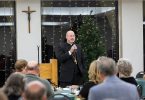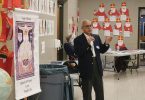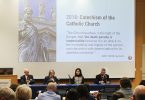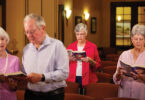
by Jill Ragar Esfeld
jill.esfeld@theleaven.org
KANSAS CITY, Kan. — After teaching art in a public school for 35 years, Phyllis Gipson retired in 2015.
But conventional retirement wasn’t a concept she could grasp.
“My father told us all the time that when you retire, you serve your community,” she said. “And he was the perfect model for that.
“The expectation to come home and sit until I die was never an option for me.”
When retirement was on her horizon, Gipson approached Cathy Fithian, principal of Christ the King School in Kansas City, Kansas, and told her she would like to teach there.
“She was in a public school catty-corner from our school,” Fithian recalled. “And she said, ‘I always knew, someday, I would be in your school to teach art.’”

Fithian told Gipson that art instruction was a luxury Christ the King could not afford.
But Gipson, a devout Christian, responded, “You don’t understand — this is my calling.”
And so, for eight years now, Gipson has been “retired” teaching art at Christ the King two days each week — and students are delighted with her wonderfully creative lessons.
“The first year, I would show up in the building with all my bags and stuff,” she said. “They would start applauding, yelling, ‘Today is art! Ms. Gipson’s here!’
“How affirming is that? It made me know I was doing something to help somebody.”

Gipson knows firsthand how important art can be to a student.
“School was difficult for me,” she said. “But I always had the art and drawing.”
Art is the subject of Gipson’s curriculum. But she believes her lessons are important for every child, because they involve so much more than art.
“Even though students are taught techniques of how to get media to move according to plan,” she said, “for the most part, I teach skills of problem solving — that’s really my focus.
“Don’t we all need problem-solving skills?”

That focus becomes clear in the third grade art class when Gipson dumps a large bin of wooden shapes on the floor and students scramble to find appropriate pieces to create angels.
The problem is there are no wings per se, so students have to improvise, finding wooden heart shapes that can work as wings.
Problem solved.

The next class of fourth graders is transforming castles they’ve drawn on paper into ceramic clay sculptures.
Unfortunately, the plastic knives allowed for cutting leave rough edges in the clay.
Students find that brushes and a little water are the perfect tools for smoothing out their creations.
Problem solved.

Another angel project is tackled by the sixth graders — drawing and painting the cherubs from Raphael’s famous “Sistine Madonna.”
But how do you reproduce such detail when your freehand drawing skills are not on par with Raphael’s?
Students use windows as makeshift light tables to trace the artist’s images.
Problem solved.
Angels are special to Gipson because her public-school curriculum was limited to secular projects.
But in Catholic schools, there is plenty of time to do angels, she said.

Gipson has raised three children of her own and is now caretaker for her mother, who lives with her, and her husband who is in a nursing home.
She attends a caregiver support group through the Keeler Women’s Center in Kansas City, Kansas, where members are counseled to do something for themselves.
“This is what I do for myself,” she said as she stacked clay castles on a shelf.
When her art lessons are done for the day, Gipson always stops by the office to thank Fithian for the opportunity.
“This is such a tender mercy for me from the Lord,” she said. “That I get to expose children to different media, and then I get to see them sail.”

Christ the King feels blessed, too.
“I think she is an outstanding educator and a beautiful person,” said Fithian. “She brings not only so much richness to our students’ lives, but she does the same for our faculty.
“She is part of our family now and we are the ones who are so gifted to have her here.”
Gipson considers her teaching a ministry, and she is happy that she’s found like-minded people at Christ the King.
“All the teachers I interact with here — they understand that,” she said, “and they have a higher calling and a higher expectation.
“They have so much compassion and love for children.”






